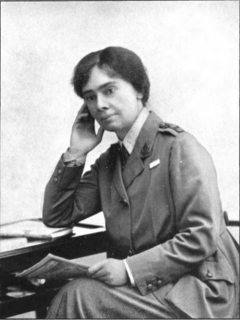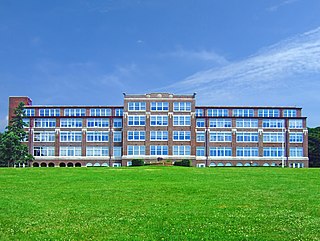
Eden Prairie is a city 12 miles (19 km) southwest of downtown Minneapolis in Hennepin County, and the 12th-largest city in the State of Minnesota, United States. It is the seventh-largest suburb in the Twin Cities, with a population of 60,797 at the 2010 census. The city is on the north bank of the Minnesota River, upstream from its confluence with the Mississippi River.

A sanatorium is a medical facility for long-term illness, most typically associated with the treatment of tuberculosis (TB) in the late-nineteenth and early-twentieth century before the discovery of antibiotics. A distinction is sometimes made between "sanitarium" or the east-European "sanatorium" and "sanatorium".
Piedmont Sanatorium was a rest home for tubercular African Americans in Burkeville, Virginia from 1917 to 1965. It was the first facility of its kind ever to be established in the United States. The Sanatorium later became the site of Piedmont Geriatric Hospital.
Frederick Feikema Manfred was an American writer of Westerns, very much connected to his native region: the American Midlands, and the prairies of the West. He named the area where the borders of Minnesota, Iowa, South Dakota, and Nebraska meet, "Siouxland."

Muirdale Tuberculosis Sanatorium, also called Muirdale Tuberculosis Hospital, was built in 1914–15 by Milwaukee County, Wisconsin. It was located near the corner of Highway 100 and Watertown Plank Road in Wauwatosa and named after noted Wisconsin naturalist John Muir. Maximum capacity in 1923 was 350 patients, but in later years this figure rose to over 600, including a 100-bed Children's Cottage, or Preventorium, devoted to the treatment of young children.

Edward Livingston Trudeau was an American physician who established the Adirondack Cottage Sanitarium at Saranac Lake for treatment of tuberculosis. Dr. Trudeau also established the Saranac Laboratory for the Study of Tuberculosis, the first laboratory in the United States dedicated to the study of tuberculosis. He was a public health pioneer who helped to establish principles for disease prevention and control.
Sanatorium is a community in Simpson County, Mississippi, U.S., northwest of Magee. The community was named for the Mississippi Tuberculosis Sanatorium, founded in 1916, which was a hospital for TB patients from 1918 to the 1950s. In 1976, the old Sanatorium facilities were transferred to the Mississippi Department of Mental Health and renamed Boswell Regional Center, which is now an Intermediate Care Facility for Persons with Mental Retardation and other developmental disabilities (ICF-MR). Its central building, Dexter Hall, received a Heritage Award for Restoration in 2014.

Glenn Dale Hospital was a tuberculosis sanatorium and isolation hospital in Glenn Dale, Maryland, in the United States. It is a large facility, consisting of 23 buildings on 216 acres (87 ha), that was built in 1934 and closed in 1981 due to asbestos.

Between 1873 and 1945, Saranac Lake, New York became a world-renowned center for the treatment of tuberculosis, using a treatment that involved exposing patients to as much fresh air as possible under conditions of complete bed-rest. In the process, a specific building type, the "Cure Cottage", developed, built by residents seeking to capitalize on the town's fame, by physicians, and often by the patients themselves. Many of these structures are extant, and their historic value has been recognized by listing on The National Register of Historic Places.

The Adirondack Cottage Sanitarium was a tuberculosis sanatorium established in Saranac Lake, New York in 1885 by Dr. Edward Livingston Trudeau. After Trudeau's death in 1915, the institution's name was changed to the Trudeau Sanatorium, following changes in conventional usage. It was listed under the latter name on the National Register of Historic Places in 1995.

Glen Lake Sanatorium, a tuberculosis treatment center serving Hennepin County in Minnesota, opened on January 4, 1916, with a capacity of 50 patients, and closed in 1976. In 1909, the Minnesota State Legislature had passed a bill authorizing the appointment of county sanatorium boards and appropriating money for the construction of county sanatoriums. Glen Lake Sanatorium was the fifth of fourteen county sanatoria that opened in Minnesota between 1912 and 1918. The sanatorium had its own post office, and the mailing address was Glen Lake Sanatorium, Oak Terrace, Minnesota, until the surrounding area was incorporated into the City of Minnetonka.

Ninette is an unincorporated community recognized as a local urban district located in Manitoba, Canada at the north end of Pelican Lake. It is located in the Rural Municipality of Prairie Lakes. Ninette has many small businesses, and is known locally for its wide range of sports facilities. In the summer, activities such as boating, fishing, and hunting are offered, while snowmobiling and ice fishing are offered during the wintertime.
The Saskatoon Sanatorium was a tuberculosis sanatorium established in 1925 by the Saskatchewan Anti-Tuberculosis League as the second Sanatorium in the province in Wellington Park south or the Holiday Park neighborhood of Saskatoon, Saskatchewan, Canada. In 1929 Saskatchewan became the first jurisdiction to implement universal free diagnosis and treatment of tuberculosis, leading to better control of the disease by the three sanatoriums in the Province.

Cranberry Specialty Hospital was a tuberculosis sanatorium and later a chronic care facility operated by Plymouth County which was operational from 1919 until 1992 in Hanson, Massachusetts.

The Minnesota State Sanatorium for Consumptives, also known as the Ah-Gwah-Ching Center, was opened in 1907 to treat tuberculosis patients. The name "Ah-Gwah-Ching" means "out-of-doors" in the Ojibwe language. The center remained a treatment center for tuberculosis until January 1, 1962. During that time, it treated nearly 14,000 patients. In 1962, it became a state nursing home known as the Ah-Gwah-Ching Nursing Home, serving geriatric patients with various mental and physical illnesses. At its peak in the 1970s, the nursing home had as many as 462 patients.
The town of Colorado Springs, Colorado played an important role in the history of tuberculosis in the era before antituberculosis drugs. Tuberculosis management before this era was difficult and often of limited effect. In the 19th century, a movement for tuberculosis treatment in hospital-like facilities called sanatoriums became prominent, especially in Europe and North America. Thus people sought tuberculosis treatment in Colorado Springs because of its dry climate and fresh mountain air. Some people stayed in boarding houses, while others sought the hospital-like facilities of sanatoriums. In the 1880s and 1890s, it is estimated that one-third of the people living in Colorado Springs had tuberculosis. The number of sanatoriums and hospitals increased into the twentieth century. During World War II, medicines were developed that successfully treated tuberculosis and by the late 1940s specialized tuberculosis treatment facilities were no longer needed.

Ethan Allen School for Boys was a reform school in Delafield, Wisconsin which operated in a former tuberculosis sanitorium from April 1959 until June 2011, when it was abolished and the inmates moved to Lincoln Hills School in Irma. It was operated by the Wisconsin Department of Corrections.
The Wooroloo Sanatorium and Cemetery is located on Linley Valley Road, Wooroloo, Western Australia. The Sanatorium operated from 1914 until transferred to Department of Corrective Services in 1970. The cemetery opened in 1915 and continues to operate.

Eleanor Soltau (1877–1962) was an English doctor who led the first unit of the Scottish Women's Hospitals for Foreign Service in Serbia.

Lake View Sanatorium is a former tuberculosis sanitorium at 1204 Northport Drive in Madison, Wisconsin. Before the introduction of antibiotics, sanatoria were used to isolate tuberculosis patients from the general public and provide them with a supportive environment in which to recover. The state of Wisconsin had a state sanatorium supplemented by a series of county and private sanatoria; as Dane County had a large private sanatorium, it lagged behind other counties in opening a public one, but the financial benefits of operating its own sanatorium convinced the county to build Lake View Sanatorium in 1929–30. The sanatorium was designed by local architects Law, Law, & Potter with the assistance of E.A. Stubenrauch, a Milwaukee architect with experience designing sanatoriums; while the building is mainly functional, it features some Art Deco elements. The building's facilities included 125 beds for patients, an operating room, facilities for outpatient care, and a large porch; as fresh air was considered the best treatment for tuberculosis at the time, patients generally spent their days and even many nights on the porch. As antibiotics made sanatoria increasingly obsolete from the 1940s onward, use of the facility declined until it closed in the 1960s; the building is now used by the Dane County Department of Human Services.
















